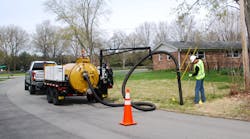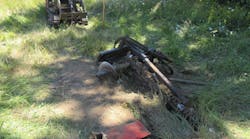Everyone has heard the phrase "competing on a level playing field" in reference to athletics. Well, working on a level playing field, or shall we say job site, is just as important in the utility construction market. And sometimes contractors can achieve this even when a job site's terrain isn't level at all.
Arnold Jones, owner of A&L Cable Services Inc. in Fayetteville, NC, experienced this firsthand when his company was hired to install 36 miles of underground fiber optic lines for a Time Warner Cable project linking a county's schools. Jones' crews found themselves working in a rural landscape with gravel roads, ditches and uneven terrain. So in order to make the working field more level, Jones enlisted the help of a ride-on tractor with an innovative quad-track system design.
Luckily for Jones, he has the experience to help him make the most out of a difficult situation. He's been in the cable installation business since its booming days in the 1980s and has successfully ridden the ebb and flow of the industry over the past three decades. Not long after gaining experience with another company, Jones saw the opportunity to venture out on his own. In March 1997, he and his wife, Lora, founded A&L Cable Services. At that time, the company had just two bucket trucks and specialized in aerial work. Today, the Joneses employ about 40 people and own four subcontractor companies.
A&L Cable Services has expanded its service offerings from aerial cable work to underground installation, maintenance and splicing. "We do most of our work for Time Warner Cable. We put in their main line cable — both underground and overhead," Jones says. "We install all of the main line cable for new subdivisions, and we'll do special projects for them if they have a big project that comes up like the one in Robeson County."
Business owners can point to many reasons behind the successful growth of the company. Jones can point to two main things — the good, quality people he's had the privilege to work with and the money he's invested back into the company by purchasing quality, reliable equipment. "It's come a long way. Years ago, you didn't even need a horizontal directional drilling (HDD) rig, but now you have to have one on almost every job," he says. "We've been able to keep the right equipment out there to do the job."
This proved true on the Time Warner Cable project in Robeson County in which Jones turned to his new Vermeer® RTX1250 ride-on tractor with the quad-track system to ensure his crews stayed on schedule.
A&L Cable Services was given three months to complete the massive project that entailed 36 miles of underground cable installation and 50 miles of aerial work. In the end, the newly installed fiber network would link all of the schools in Robeson County on one fiber system, enabling school officials to communicate and share information more effectively.
When Jones and his crews started work on the job site at the beginning of September, they chose their rubber tire unit to plow the 2-inch conduit 36 inches deep. Though the machine was able to do the job, Jones says the uneven terrain and sandy clay loam in the rural area's rights of way posed challenges for the rubber tire machine.
"We were on the right of way, but in most cases, we had to be in the ditch or behind the ditch in the right of way," Jones says. "In a lot of situations when you're at the bottom of a ditch with a machine like that, you just have to pull the machine out and backhoe that area, which slows the process down a lot."
Just as Jones began pondering ways to keep his crews on pace to meet the demanding three-month deadline, he got a call from his Vermeer salesman asking if he'd like to demo the new Vermeer RTX1250. "Because our rubber tire unit was a 1999 model, we were looking to replace it," Jones says. He had already tried out the RT1250 ride-on tractor with rubber tires and was impressed by its performance, so he was especially interested in seeing what the RTX1250 with the quad track system could do. Fortunately for him and his crews, the machine couldn't have come at a better time.
"We tried it for a day or two, and it did such a good job that we decided to go ahead and purchase it," Jones says. "With this machine, we were able to put it on the back side of the ditch, on uneven terrain — wherever we needed it to go — and it would still do the job."
By increasing side-hill stability and floatation in soft or sandy soils, the quad track system on the RTX1250 can help improve productivity by allowing contractors to work in a broader range of weather and ground conditions. The quad-track system has relatively no break-over point, which allows for full power to all four tracks whether or not the tractor is moving, and maximizes tractive effort and stability by maintaining four-point contact with the ground. The unit's innovative design also offers contractors the ability to switch between rubber tires and rubber quad tracks depending on the job application.
"With the quad track system, you can put it on a bank or slope without having to worry about stability. Plus, it's not like a rubber tire machine where you have one tire off the ground and that might be your pulling tire," Jones says. "It lies on the ground with all four tracks, so you've got plenty of pull power."
Although production rates vary by job site due to various ground conditions, the numbers showed on this site how productive crews were with the unit. Using a vibratory plow blade on the machine, Jones says his crews were able to plow an average of 6,000 feet per day. "We ran into problems with the locating service keeping up with us because we were moving so fast," he says.
Ironically, weather had been on Jones' side early in the job. He says that region of North Carolina is typically wet in the fall, but due to a drought the previous summer, his crews didn't have to contend with wet conditions in the ditches and rights of way — at least not until rains hit in late November. "We had a few places that got kind of wet, but with that machine having tracks, it didn't slow us down," he says.
In addition to the RTX1250, A&L Cable Services crews had an HDD rig stationed at the job site for boring under roads, creeks and other obstacles. Jones says the HDD machine would work out ahead of the RTX1250 installing the conduit under highways and roads, and then the RTX1250 would pick up where the HDD rig had left off.
By the first of December, Jones and his crews had completed the $700,000 underground installation portion and the 50 miles of aerial work. They could have completed installation of the underground fiber optics with a rubber tire unit, but Jones says it would have taken them a month or two longer. Having the RTX1250 provided the pull power and tractive effort that they needed — putting them on a level working field to complete their job before deadline.
"In this area, we're pretty well known for being one of the bigger and better companies in the utility business, and our reputation speaks for itself," Jones says. "It has a lot to do with having the right people out there and the right equipment."




